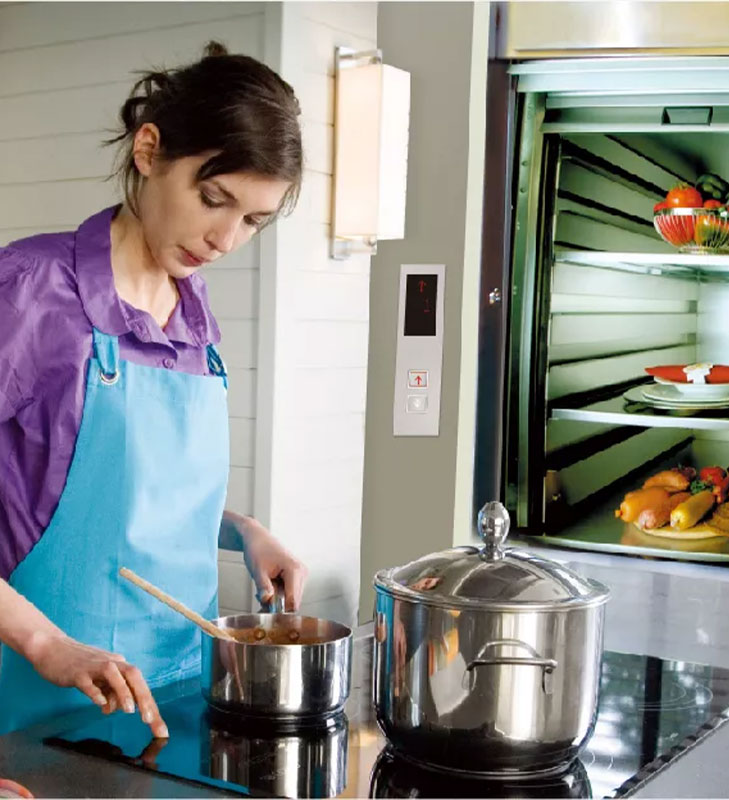Dumbwaiter elevators, often used in restaurants, hotels, residential homes, and industrial settings, provide a convenient way to transport food, documents, laundry, or small goods between floors. While they are smaller and simpler than traditional passenger elevators, dumbwaiters still rely on mechanical and electrical systems that require proper care. Understanding the need for regular maintenance is crucial to ensure safety, efficiency, and longevity.
1. Importance of Regular Maintenance
Dumbwaiter elevators may seem simple, but they are complex systems involving motors, pulleys, cables, doors, and control panels. Regular maintenance is important for several reasons:
- Safety: Faulty components, such as worn cables, malfunctioning door interlocks, or control system issues, can cause accidents. Maintenance ensures all parts function correctly, reducing risk of injury.
- Reliability: Frequent use in restaurants, hotels, or multi-story homes means that even minor wear can lead to breakdowns. Routine inspections help prevent unexpected failures.
- Longevity: Well-maintained elevators last longer. Preventative care avoids premature replacement of expensive components.
- Efficiency: Regular lubrication and adjustments help the dumbwaiter operate smoothly and quietly, improving the user experience.
Without maintenance, dumbwaiters are prone to mechanical wear, electrical faults, and decreased performance, which can compromise both safety and efficiency.
2. Key Components Requiring Maintenance
Several critical components of a dumbwaiter elevator need attention:
- Motor and Drive System: The motor powers the elevator. Regular inspection includes checking wiring, lubrication, and alignment, as well as testing for unusual noises or vibrations.
- Cables and Pulleys: These bear the load of the elevator. Cables must be checked for fraying or stretching, and pulleys must rotate freely without obstruction.
- Door Mechanisms: Dumbwaiter doors have interlocks to prevent operation when open. Regular maintenance ensures that these mechanisms work reliably, avoiding accidents.
- Control Systems: Electrical panels, switches, and buttons must be inspected for wear or short circuits. Faulty controls can cause the elevator to stop unexpectedly or operate unsafely.
- Cab and Track: The cabin and its guiding tracks need cleaning and lubrication to prevent sticking, vibration, or misalignment.
Proper maintenance ensures that each component operates safely and efficiently, minimizing downtime and repair costs.
3. Recommended Maintenance Schedule
Dumbwaiter elevators should ideally follow a preventive maintenance schedule, which may include:
- Monthly Checks: Inspect door mechanisms, control panels, and safety features for obvious wear or damage.
- Quarterly Maintenance: Lubricate moving parts, check cable tension, and inspect the motor and pulleys.
- Annual Inspection: Comprehensive review by a qualified technician, including load testing, safety system verification, and electrical inspections.
The exact schedule may vary depending on usage frequency, load weight, and environmental conditions, but consistent inspections help prevent costly failures.
4. Signs That Maintenance Is Needed
Even with a routine schedule, dumbwaiter users should be alert to warning signs:
- Unusual noises during operation (grinding, squeaking, or rattling).
- Slow or jerky movement of the elevator cabin.
- Door malfunctions, such as doors not closing or opening properly.
- Control panel errors or failure to respond.
- Vibrations or misalignment of the cabin on the track.
Addressing these signs early can prevent serious accidents or costly repairs.
5. Benefits of Regular Maintenance
Regular maintenance offers several benefits:
- Enhanced safety: Reduces the risk of accidents due to mechanical or electrical failure.
- Extended lifespan: Prevents premature wear, ensuring the dumbwaiter lasts for years.
- Operational efficiency: Smooth and quiet operation improves user satisfaction.
- Cost savings: Preventive maintenance is generally less expensive than emergency repairs or full component replacements.
In commercial settings, such as restaurants or hotels, downtime can disrupt operations, so regular maintenance also ensures business continuity.
6. Professional Maintenance Services
While some light maintenance tasks (like cleaning and lubrication) can be performed by trained staff, professional service is recommended for major inspections and repairs. Certified technicians have the experience, tools, and safety knowledge to:
- Conduct load testing.
- Inspect and replace worn cables or pulleys.
- Verify control system functionality.
- Ensure compliance with local elevator safety regulations.
Engaging professional services periodically guarantees that the dumbwaiter operates safely and efficiently.
Conclusion
Yes, dumbwaiter elevators require regular maintenance to ensure safety, reliability, and longevity. Despite their small size and seemingly simple operation, dumbwaiters contain critical mechanical and electrical components that can wear over time. Routine inspection, lubrication, and professional servicing prevent accidents, reduce downtime, and extend the life of the elevator.
For homes, restaurants, hotels, or industrial settings, adhering to a preventive maintenance schedule is essential. Properly maintained dumbwaiter elevators operate smoothly, safely, and efficiently, making them a valuable and dependable asset for daily operations.












